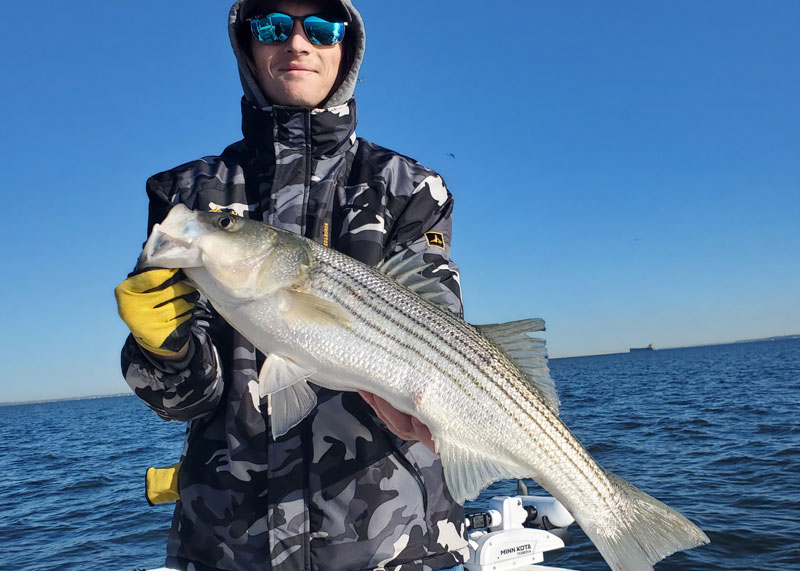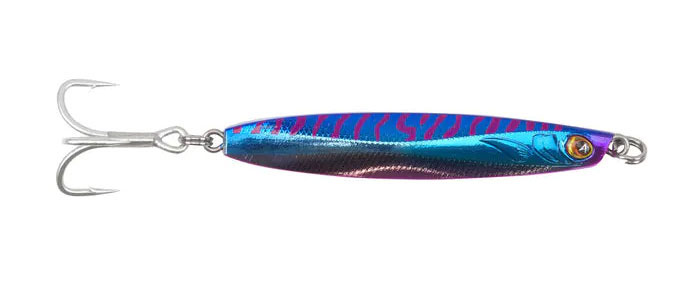It’s 45 degrees, you see striped bass down deep on the meter, and as you stand there shivering you’re wondering why the heck you can’t get a bite when the day before rockfish were thrashing on the surface. We’ve been there, too. And while we can’t say exactly why this fish or that one will or will not bite at any given time — these are wild creatures, after all, doing what they want when they want — there’s a very good chance those fish are responding to an abrupt pressure change. Because when the pressure suddenly spikes, quite often at this time of year the fish go down to 40-plus-foot depths and sit there as though they no longer had any urge nor need to eat a darn thing.

Reality check: when you encounter this scenario, it will be tough to go home a winner. That said, if you work those fish hard you should be able to get a few bites. It almost certainly won’t suddenly change to fast action and you’ll be working a bite that’s somewhere between tough and nonexistent, so if you can tease three or four fish into biting consider it a victory. Still, we have to play the hand we’re dealt — here’s how to make the best of it.
Fishing Deep
If you’re a light tackle angler who has been chasing birds up until now, the first part of the challenge will be locating fish. Will you have to travel? Maybe; there have been years when December fishing was great up at the Bay Bridge, there have been years when it was best down at the CBBT, and there have been years when it was hot in-between. Generally speaking, however, in recent years the Point Lookout area has held the lion’s share of the fish.
The best move will be to head for areas where they were recently caught (you’ve been paying attention to the fishing reports at FishTalkMag.com, haven’t you?), and begin a search on the meter. Don’t bother looking in water shallower than 35’ and look out to 60’ or so deep. Until you start seeing marks you might as well search just as fast as your boat and fishfinder allow a decent reading, and remember that quite often even if the fish aren’t up top, on calm days, you may see scattered sitting birds floating around in the general area.
When you start seeing marks or hordes of bait, slow down and begin searching into the prevailing force be it wind or current. If you see a stack of fish consider yourself exceptionally lucky; these days, spotting small clusters of seven to 10 marks is a lot more likely. And those clusters are enough to work with, as opposed to singles or doubles which are generally not worth the time spent dropping on.
That Sinking Feeling
So, what are you going to drop? You can tie on a supersized jighead, but in depths like this fast-sinking jigging spoons work one heck of a lot better. Not wobblers, mind you, jigging spoons that are designed to get down and get down fast. And bottom hooks are usually best in this scenario, not the top-rigged swingers designed for speed jigging spoons, because quite often the fish will be grabbing the aft end of the spoon halfheartedly as opposed to crushing it. As you choose your weapon also remember that at these depths most colors turn gray. Blue, purple, and green are colors that retain visibility to 60’ or more, and not coincidentally, happen to be excellent choices for heavy jigging spoons.

Working the spoons with long sweeps of the rod and allowing them to fall as naturally as possible until hitting bottom while maintaining minimum tension is usually the best move. As a general rule of thumb you’ll get hit on the fall, and know to set the hook when the spoon seems to hit bottom a few feet too soon. Sometimes. Other times…
Remember, these fish aren’t particularly active and don’t really want to eat all that much. If jigging spoons are going untouched, a snakish teaser sometimes does the trick so try tying up a dropper line three or four feet above the spoon, with a bare long-shank hook on the end. Then add on a tempting, tasty morsel that has some good action without a lot of fast motion, like a skinny five-inch twister tail. Rather than big sweeping jigs, just slowly raise and lower your rod tip just enough to get that tail wiggling; if there isn’t much of a drift and you’re not sure how slowly you can move the rig and still get some action out of the tail, hold it next to the boat and watch it for a moment or two as you gently jig.
Pulling for a Win: Trolling During Pressure Swings
Another way to potentially get those fish to start snapping is to troll for them. The downside here is that in order to keep your offerings down at the fish’s level, you’ll need to use about 3000 ounces of lead. Well, maybe not that much, but to troll an umbrella at these depths trolling sharpies will tell you that you will want to be measuring lead by pounds not ounces, use braid not mono, and creep along as slowly as possible. That said, umbrellas and tandems will both sometimes work in this scenario.
Sure, we’d all rather be out there when the rockfish are churning the water’s surface. Yeah, we wish it was warm enough to take off that parka. But in December the weather conditions don’t always cooperate. And if you still want to feel that tug on the end of your line, you’ll have to overcome the pressure.